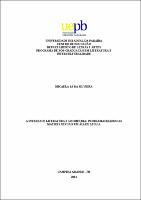| Compartilhamento |


|
Use este identificador para citar ou linkar para este item:
http://tede.bc.uepb.edu.br/jspui/handle/tede/2600| Tipo do documento: | Dissertação |
| Título: | A interface literatura e geometria: problematizando as matizes sexuais em Állex Leilla |
| Autor: | Silveira , Micaela Sá da |
| Primeiro orientador: | Silva, Antonio de Pádua Dias da |
| Resumo: | O objetivo da pesquisa foi problematizar a noção de ser/estar homem e mulher, bem como utilizar os objetos geométricos para discutir as relações afetivas e sexuais vivenciadas pelos personagens de três obras literárias da autora baiana Állex Leilla: Henrique (2001), O sol que a chuva apagou (2009) e Primavera nos ossos (2010). As questões discutidas passam pela problematização das definições sobre o que é ser homem e mulher; bem como de hetero e homossexualidade, enquanto imposições criadas a fim de enquadrar os sujeitos. Para tal estudo, apropriamo-nos do conceito de “entre-lugar”, discutido por Santiago ([1978] 2000), apresentando um novo significado e outra grafia, “entrelugar”, propondo uma maneira de (re)pensar as personagens/sujeitos apresentados nas obras analisadas e as relações que estes estabelecem. Ainda conceitualmente, colocamos em debate as relações que comumente são chamadas de “triângulos amorosos” e utilizamos as teorias matemáticas para encontrar outro objeto geométrico que possa ser visto como um “desenho” representativo dos envolvimentos afetivos e sexuais. Dessa forma, a pesquisa tomou os conceitos da Geometria Euclidiana, no que se refere aos objetos geométricos, como metáfora para dizer das relações afetivo-sexuais com o outro e/ou com os outros. Ao fim da pesquisa, percebe-se que, nas obras analisadas, as personagens não se enquadram nos moldes binários, social e culturalmente difundidos do que é ser homem e/ou mulher e, por isso, podem ser e/ou estar homem e mulher em um espaço de entrelugar. Diante das performances das personagens analisadas, as definições para as categorias acima mencionadas não são satisfatórias. Para além disso, nota-se que as relações vivenciadas podem ser metaforicamente representadas pela figura do espiral, numa perspectiva tridimensional, tendo em vista que este objeto geométrico configura-se uma revolução que tem como ponto de partida um ponto fixo, mas está em constante construção, apresentando, assim, possibilidades ilimitadas para as relações entre os sujeitos – independente de quem seja o objeto de desejo afetivo e/ou sexual. |
| Abstract: | This research aims to problematize the notion of being male and female, as well as to utilize geometric objects to discuss the affective and sexual relationships experienced by the characters of three literary books by Bahia-native author Állex Leilla: Henrique (2001), O sol que a chuva apagou (2009), and Primavera nos ossos (2010). The questions discussed go through the problematization of the definitions about what it means to be male and female; as well as heterosexuality and homosexuality while impositions created in order to frame the subjects. For this study, we took the concept of “space in-between”, discussed by Santiago ([1978] 2000), presenting a new meaning and another spelling for it, “inbetween”, and proposing a new way of (re)thinking about the characters/subjects presented in the analyzed works, and the relationships they establish among each other. Conceptually still, we put under debate the relationships commonly referred to as “love triangles,” and used mathematic theories to find another geometric object that could be seen as a representative “image” of these affective and sexual involvements. This way, the research took concepts from Euclidian Geometry, in regard to geometric objects, as a metaphor to talk about affective-sexual relationships with the other and/or with the others. At the end of the research, we noticed that, in the analyzed works, the characters do not fit the socially and culturally popularized binary molds of what it means to be male and/or female, and, thus, they can be male and female in a space of entrelugar (inbetween). Through the analyzed characters‟ performances, the definitions for the aforementioned categories are unsatisfactory. Beyond that, we noticed that the relationships experienced can be metaphorically represented by an spiral image, in a tridimensional perspective, since this geometric object is a revolution whose starting point is a fixed point, but it is in constant making, presenting, thus, unlimited possibilities for the relationships among the subjects – regardless of who is the object of affective and/or sexual desire. |
| Palavras-chave: | Ser/estar. Entrelugar. Objetos geométricos. |
| Área(s) do CNPq: | CIENCIAS SOCIAIS APLICADAS |
| Idioma: | por |
| País: | Brasil |
| Instituição: | Universidade Estadual da Paraíba |
| Sigla da instituição: | UEPB |
| Departamento: | Centro de Educação - CEDUC |
| Programa: | Programa de Pós-Graduação em Literatura e Interculturalidade - PPGLI |
| Citação: | Silveira , Micaela Sá da. A interface literatura e geometria: problematizando as matizes sexuais em Állex Leilla. 2014. 108 p. Dissertação (Programa de Pós-Graduação em Literatura e Interculturalidade - PPGLI) - Universidade Estadual da Paraíba, Campina Grande. |
| Tipo de acesso: | Acesso Aberto |
| URI: | http://tede.bc.uepb.edu.br/tede/jspui/handle/tede/2600 |
| Data de defesa: | 29-Abr-2014 |
| Aparece nas coleções: | PPGLI - Dissertações |
Arquivos associados a este item:
| Arquivo | Descrição | Tamanho | Formato | |
|---|---|---|---|---|
| PDF - Micaela Sá da Silveira.pdf | 1.61 MB | Adobe PDF |  Baixar/Abrir Pré-Visualizar |
Os itens no repositório estão protegidos por copyright, com todos os direitos reservados, salvo quando é indicado o contrário.




